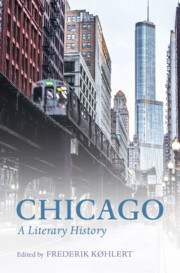Book contents
- Chicago: A Literary History
- Chicago
- Copyright page
- Contents
- Figures
- Contributors
- Acknowledgments
- Introduction: The Literary History of Chicago
- Part I The Rise of Chicago and the Literary West
- Part II Business Unusual: A New Urban American Literature
- Part III Radicalism, Modernism, and the Chicago Renaissance
- Chapter 11 Progressive Chicago: Upton Sinclair, Jane Addams, and Social Reform Literature
- Chapter 12 From the Prairie to the City: Willa Cather’s “City of Feeling”
- Chapter 13 Poetry, the Little Review, and Chicago Modernism
- Chapter 14 A Spirit of Two Ages: The Romantic Modernism of Carl Sandburg’s Chicago Poems
- Chapter 15 Building a Movement: Mary Reynolds Aldis and Little Theatre in Chicago
- Chapter 16 Father to Son: Floyd Dell, Sherwood Anderson, and the Chicago Renaissance
- Part IV A City of Neighborhoods: The Great Depression, Sociology, and the Black Chicago Renaissance
- Part V Traditions and Futures: Contemporary Chicago Literatures
- Selected Bibliography
- Index
Chapter 11 - Progressive Chicago: Upton Sinclair, Jane Addams, and Social Reform Literature
from Part III - Radicalism, Modernism, and the Chicago Renaissance
Published online by Cambridge University Press: 02 September 2021
- Chicago: A Literary History
- Chicago
- Copyright page
- Contents
- Figures
- Contributors
- Acknowledgments
- Introduction: The Literary History of Chicago
- Part I The Rise of Chicago and the Literary West
- Part II Business Unusual: A New Urban American Literature
- Part III Radicalism, Modernism, and the Chicago Renaissance
- Chapter 11 Progressive Chicago: Upton Sinclair, Jane Addams, and Social Reform Literature
- Chapter 12 From the Prairie to the City: Willa Cather’s “City of Feeling”
- Chapter 13 Poetry, the Little Review, and Chicago Modernism
- Chapter 14 A Spirit of Two Ages: The Romantic Modernism of Carl Sandburg’s Chicago Poems
- Chapter 15 Building a Movement: Mary Reynolds Aldis and Little Theatre in Chicago
- Chapter 16 Father to Son: Floyd Dell, Sherwood Anderson, and the Chicago Renaissance
- Part IV A City of Neighborhoods: The Great Depression, Sociology, and the Black Chicago Renaissance
- Part V Traditions and Futures: Contemporary Chicago Literatures
- Selected Bibliography
- Index
Summary
During the period between 1890 and 1920, the United States was transformed from a largely agricultural and rural nation to one that was industrial and urban, and it wrestled with social problems concerning race, gender, and immigration. Progressivism emerged out of this context. By the turn of the century, a newly radicalized and resolute middle class launched an epic program of reforms, aiming to solve America’s social, economic, and political problems. Chicago became an important center of progressive activity. By the close of the nineteenth century, the city was home to businessmen who had achieved unprecedented levels of wealth. Meanwhile, Chicago’s numerous poor endured squalid conditions. The discrepancy between the promises made by the city and the lives lived by many of its inhabitants was depicted by progressive authors, including Upton Sinclair in his novel The Jungle (1906) and Jane Addams in her memoir Twenty Years at Hull House (1910). This chapter examines Chicago’s longer history of civic unrest going back to the Haymarket affair of 1886 and beyond, and it shows how Sinclair and Addams in different ways challenged Americans to come together with renewed moral purpose
Keywords
- Type
- Chapter
- Information
- ChicagoA Literary History, pp. 153 - 166Publisher: Cambridge University PressPrint publication year: 2021

